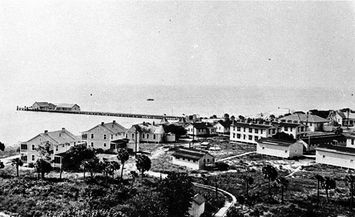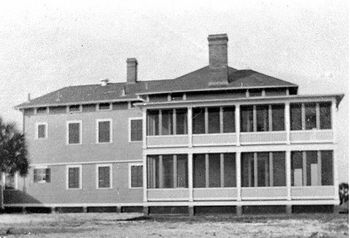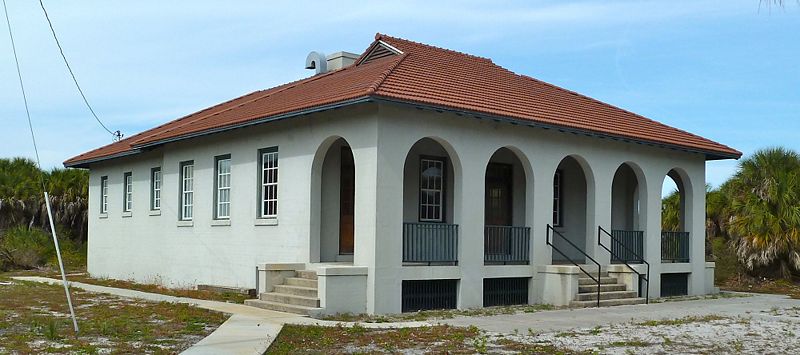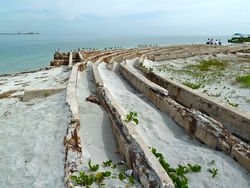Fort Dade (3)
|
Fort Dade (3) (1899-1946) - A U.S. Army Endicott Period coastal defense fort established in 1899 on Egmont Key, Pinellas County Florida. Named in G.O. 43, 4 Apr 1900 for Major Francis L. Dade, 4th U.S. Infantry, who was killed along with his entire command by hostile Seminole Indians 28 Dec 1835. Abandoned in 1923 and put into caretaker status but reactivated during World War II. Permanently abandoned in 1946. Endicott Period (1890-1910)Part of the Harbor Defense of Tampa Bay. A U.S. Army Endicott Period coastal defense fort established in 1899 on Egmont Key, Pinellas County Florida. Fort Dade was built out as a two-company U.S. Army Endicott Period coastal defense fort. Initial construction of the post buildings was completed in 1899-1900 and included two 109 man artillery barracks, officers quarters, a hospital, mess hall, administration building, a guardhouse, and various support buildings. An expansion of the post took place 1908-1911 and added commanding officer quarters, NCO quarters, a gym, a fire station, and a new guardhouse. A power plant built in 1919 was the last major building built on the post. Construction of the Endicott Period gun batteries on Egmont Key began in 1898 and continued through 1906. Initially, construction began with the larger caliber batteries, 8" Battery McIntosh (1) on the north end of the key and 6" Battery Burchsted on the south end. Both of these batteries were in service by 1900. An additional 6" battery, Battery Howard was placed in service on the north end in 1906. With the decision to establish a mining capability for the entrances to Tampa Bay it was necessary to establish smaller caliber batteries to protect those minefields from small, high-speed minesweepers. Three, 3" gun batteries were built to look over the minefields, Battery Mellon on the north end and Battery Page on the south end. A 3" gun was also added to Battery Burchsted on the south end. Construction of mining facilities began in 1901 with the construction of a cable tank. In 1906 all of the 3" gun batteries were completed by 1906 and in 1908 a system of mine control stations was established on the key. Two mine casemates, one on the north end of the key and another on the south end, were built in 1910 to control mines on both ends of the island.
World War IIn 1916, as the U.S. prepared for the inevitable entry into World War I, the mining capability of Fort Dade was expanded on the north end of the key to include a new loading room, a service dynamite room, a new wharf, and a tramway. Other forces were acting on the armament at the fort and the guns of Battery Howard were removed for service overseas. After the war ended the rapid disarmament saw all the gun batteries disarmed except for Battery McIntosh (1) and the guns removed by 1921. A Tampa Bay Hurricane on 25 Oct 1921 caused damage to many of the permanent post buildings and totally destroyed the boathouse and wharf. The high cost of repairs weighed heavily in the decision to close the post in 1923. Battery McIntosh (1) was deactivated and the post was put into caretaker status with a single caretaker on 25 May 1923. The government was unable to sell the surplus property and it remained on the quartermaster's books through 30 Jun 1935. Fires in 1925 and 1927 destroyed major permanent buildings including both of the 109 man artillery barracks and mess hall facilities. The U.S. Coast Guard took over the key in the late 1930s and used it as a small arms practice range. During World War II it was used for lookout posts. The key was designated a National Wildlife Refuge in 1974 and in 1989 Egmont Key State Park opened.
Current StatusEgmont Key Florida State Park, Pinellas County Florida. Access by ferry from Fort De Soto or private boat. One restored post building, the guardhouse, is not open to the public. Access to the southern part of the key is restricted and not allowed by land. The sunken batteries can be accessed by private boat. No period guns or mounts in place.
Sources:
Links: Visited: 2 Feb 2012
| ||||||||||||||||||||||||||||||||||||||||||||||||||||||||||||||||||||||||||||||||||||||||||||||






